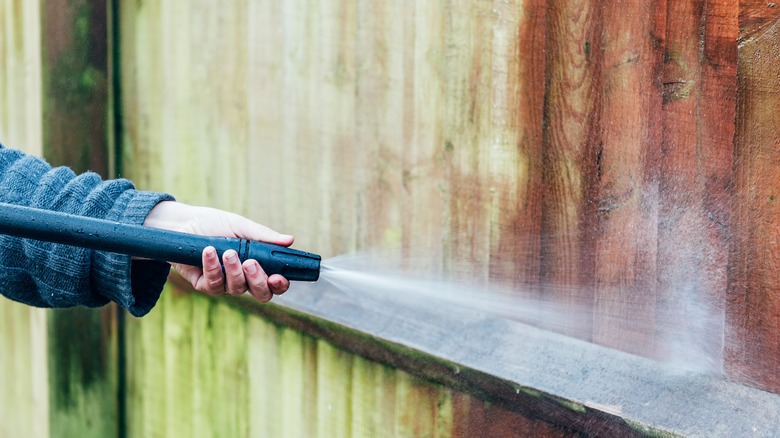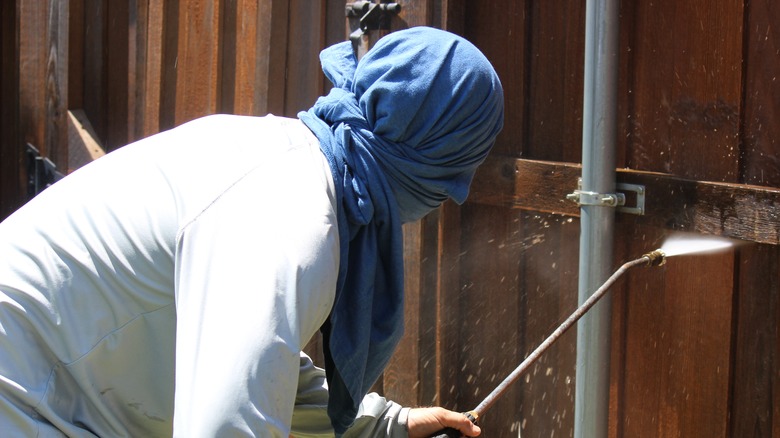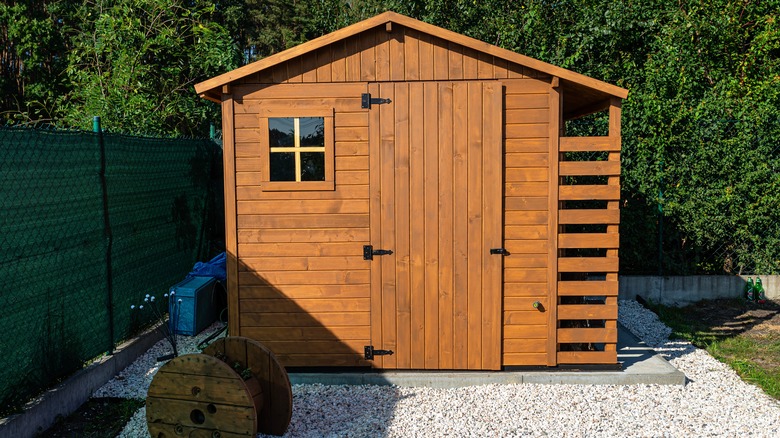Here's Why Pressure Washing Isn't Always The Best Way To Clean A Shed
Are you finally getting around to cleaning your shed? A thorough cleaning never hurts, as the shed is bound to accumulate pollen, mold, dust, algae, bird poop, and other types of unsightly filth during the course of a year. But before you venture out to the backyard with your pressure washer in tow, stop for a minute so we can explain why a shed is one of the things you should never clean with a pressure washer.
If you've ever accidentally sprayed yourself with a pressure washer's nozzle, you know how unpleasant the feeling is. That's because of the immense pressure at which water exits the nozzle. (It's even worse with a power washer, where the water is heated.) That intense water pressure is one of the downsides to using a pressure washer to clean wooden items like a shed's siding.
While you can pressure wash a shed with vinyl or use the lowest setting for a metal shed, the pressure is high enough to damage a wooden shed's paint or finish, its siding, and any window screens you have installed. So unless you want to turn your pressure-washing adventure into a full shed repainting, use something else to clean a wooden shed. Luckily, you can give wooden sheds an effective cleaning and get rid of all the offending grime without using a pressure washer. Sure, you may miss out on the satisfaction of watching that water jet blow accumulated dirt to smithereens, but you'll also avoid damaging the shed.
How a pressure washer can damage your shed
A pressure washer sends out compressed water at a pressure that can go as high as 4,000 PSI. That's 4,000 pounds of pressure for every square inch of the surface the washer strikes with its water jet. It's no wonder that pressure washers are commonly used for paint removal, where pressures of 2,000 to 3,000 PSI usually suffice. Now, there's a tool for every job, and pressure washers excel at scraping off old paint. But if all you're planning to remove is mold, algae, or pollen, there's no reason to punish your shed's paint finish (and yourself) by pressure washing.
Paint isn't the only component that can suffer irreparable damage as a result of pressure washing. The surface it protects — wood — is often vulnerable to destruction caused by a powerful water jet. Unfortunately, the type of wood that's most suitable for sheds is also the least resistant to the immense force of a pressure washer's stream. Redwood and cedar are popular choices for shed siding because of their ability to resist the elements and insect infestations. But these materials have a soft core that gets easily damaged if the water pressure is too high. Unless you know how to calibrate the pressure to an ultra-low setting like 400 to 500 PSI, you risk getting permanent damage that may include broken wood fibers and marks on the surface. Window screens are just as susceptible to being defaced by pressure washers.
The best way to clean a wooden shed
Instead of exposing yourself to a potentially damaging cleaning method like pressure washing, try a more gentle, effective approach. Begin by scrubbing the walls with a stiff-bristle brush. Thoroughly clean the entire surface of the walls, and pay particular attention to pollen, dirt, grime, and twigs. Don't disregard areas affected by mold and algae, either. Though the brush won't get them off completely, it will prepare these biological growth for the next step: biocidal washing.
There are a number of cleaning agents you can use to remove mold or algae from the wood siding of a shed. For example, one of the easiest ways to clean mold is with a commercially sold biocidal wood cleaner, like this product sold at HomeDepot. Alternatively, you can use a gentle bleach, water, and dish soap solution to get rid of any mold, mildew, and algae. The bleach-to-water ratio should be 1 to 10. Instead of using a pressure washer, spray the solution onto the wood siding and follow up with a garden hose. As you spray, take care not to get any water into the shed's soffits; otherwise, you risk trapping water inside the structure. Also, move, cover, or avoid any nearby plants, since the biocidal cleaning agent can harm them. Covering them with plastic and channeling the runoff away from them should shield them from harm. Once you're done spraying the shed with a biocidal cleaner, scrub the walls again to remove the leftover grime.


